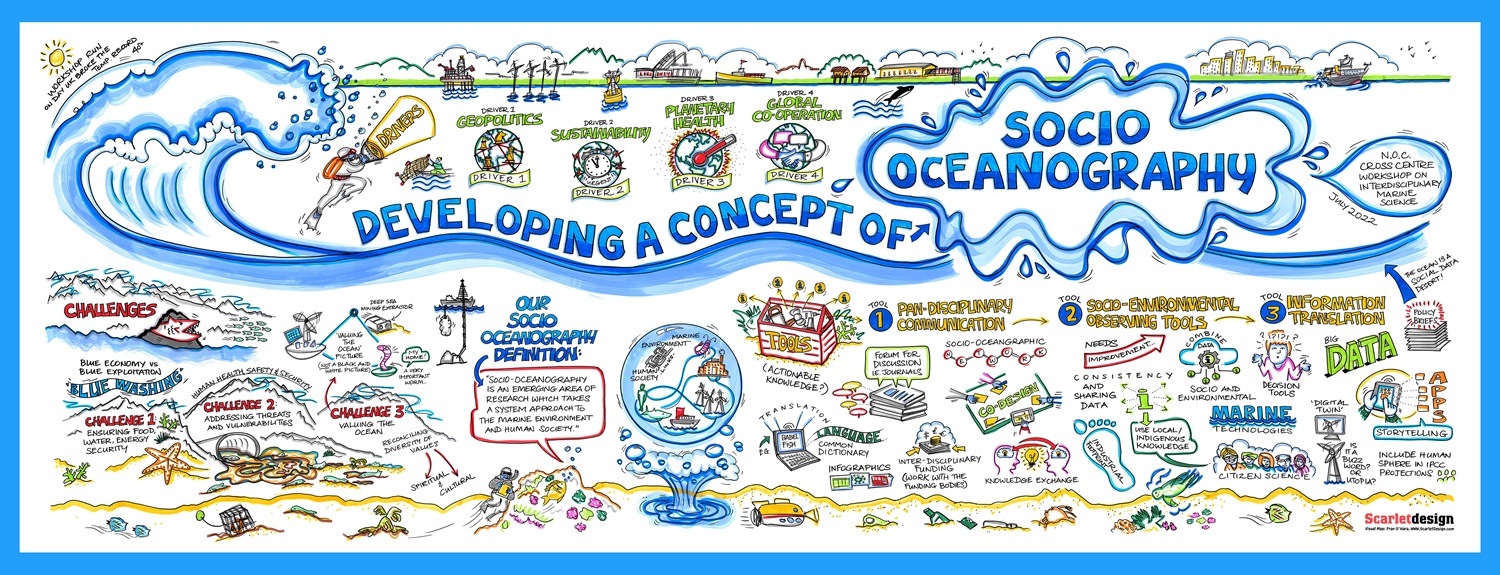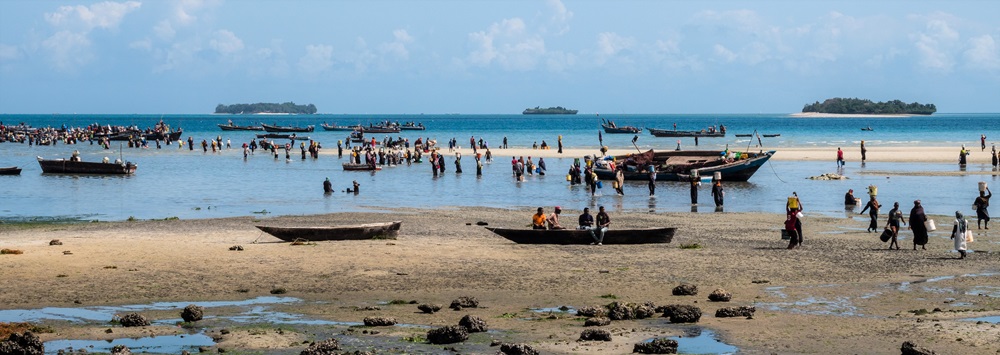FROM OCEAN CURRENTS TO SOCIETY: Navigating the multidimensional realm of socio-oceanography
An introduction: What is socio-oceanography?
Socio-oceanography can be described as an interdisciplinary approach to understanding the complex web of interactions between the marine environment and human society. This emerging and innovative discipline delves into the challenges that demand a concerted effort from both natural and social sciences, particularly those instances where the feedback between human and natural elements are just beginning to surface. But you might be wondering, how does this differ from marine socio-ecology, which also explores the interconnections between humans and ecosystems? And why do we need yet another area of research dedicated to the oceans?
Just like socio-ecology, socio-oceanography encompasses both social and natural components, recognizing the complex feedback loops between them. However, the scope of socio- oceanography extends further. It ventures into a realm where the living components of marine ecosystems do not necessarily take centre stage in understanding its environmental dynamics. Socio-oceanography takes a comprehensive view of the natural ocean and marine systems, addressing not only ecological aspects but also the physical and chemical factors that play crucial roles in shaping the marine environment and its interactions with society. These interactions often transcend ecosystems, delving into more fundamental and basic aspects of our relationship with the ocean.

Figure 1. Developing a concept of socio-oceanography: graphical notes of a conceptualization. This image was published in an open- access article distributed under the terms of the Creative Commons Attribution License (CC BY). The image was produced by Scarlet Design International, Ltd, Cardiff, United Kingdom.
Some examples of socio-oceanographic problems that extend beyond traditional socio-ecological spheres of interest include, for instance, how marine hazards impact subsea telecom cables. This influences not only the physical infrastructure but also their social and economic significance. With marine construction on the rise, we must consider its effects on the physical and chemical characteristics of the marine environment and explore its impact on various aspects of coastal human connections with the ocean as a place of belonging, work, inspiration, and connection. Looking at the emergence of new shipping routes due to Arctic sea-ice loss, we want to examine how emissions from increased Arctic shipping provide feedback loops that impact both regional and global climates. When diving into the intricate web of interactions involved in ocean-based carbon dioxide removal, we must consider proposed interventions, climate responses, ecological impacts, public acceptability, unintended consequences, and the need for responsible and equitable governance.
As an area of research, Socio-oceanography represents a compelling opportunity for natural scientists to broaden their horizons and collaborate across disciplines. It provides a platform to develop and reinforce their narratives of contribution to the solutions needed to tackle pressing ocean challenges. In this collaborative approach, scientists from diverse backgrounds can pool their expertise, jointly exploring the complexities of the marine world, and ultimately, driving forward innovative solutions that benefit both the oceans and society at large.
The concept of interdisciplinary science may seem self-evident, yet uncovering true examples of such studies, and designing new ones, proves surprisingly challenging. Often, what is labelled as ‘interdisciplinary’ amounts to a singular discipline or a collection of disciplines coexisting in time and space, contributing independently to a broader challenge.
The role of a socio-oceanographer
Let's delve into specific examples, beginning with marine fisheries—a long-standing emblem of interdisciplinary approaches. Traditionally, a sociologist looks into the intricate influence of social structures, power dynamics, and governance systems on the access to and distribution of marine fisheries resources among diverse social groups. In parallel, an anthropologist meticulously scrutinizes the impact of cultural beliefs, rituals, and traditions on the shaping of fishing practices within specific communities. A marine biologist, on the other hand, focuses on inquiries related to the reproductive strategies and habitat preferences of key commercially exploited species, shedding light on the complex ecological dynamics at play.

Figure 2. Fisheries landing site near Mangapwani village, Zanzibar, Tanzania © National Oceanography Centre, UK (SOLSTICE project).
Physical oceanographers explore how oceanographic processes such as currents, upwelling, and temperature variability influence nutrient supply, which consequently shapes the primary productivity of marine systems. In contrast, a socio-oceanographer will tackle a different set of questions.
For instance, does the intensity of upwelling impact the catches of small pelagic fish, thereby affecting the food security of coastal communities? Can an early warning system, projecting a temporal decline in upwelling intensity, empower local governments to proactively ready themselves for a potential reduction in catches during a particularly bad year? The critical question arises: will a 6-month warning period be sufficient for adequate preparation in the face of a potentially catastrophic decline in fisheries, and can local political structures place trust in a high-risk warning?
Addressing these queries necessitates a coordinated study, drawing upon the expertise of professionals in ocean dynamics, ecosystems, sociology, and economics. Alternatively, a collaborative effort of experts in coupled ocean-atmosphere dynamics, biogeochemistry, sociology, anthropology, and human geography could address questions such as, how do monsoonal variations in ocean currents and upwelling systems influence the cultural fishing practices of coastal populations in the Indian Ocean?
In each of these inquiries, input from every collaborating discipline extends beyond existing knowledge, requiring specially designed methods and tools. The crux lies not only in recognizing the need for interdisciplinary collaboration, but also in formulating questions that genuinely demand and benefit from the integration of diverse perspectives and expertise.
Amid the growing emphasis on interdisciplinary collaborations, a plethora of terminologies has emerged, presenting diverse perspectives on the distinctions between cross-disciplinary, multi- disciplinary, interdisciplinary, and transdisciplinary approaches.An area that has become somewhat contentious is the position of research involving non-academic actors within this spectrum. While there aren’t any universally right or wrong definitions, arriving at shared understandings becomes imperative for collaboration to be effective.
The challenges
So, what are the barriers to effective interdisciplinary research? Various perspectives on this topic currently exist. Aside from the obvious need to change the mindsets of individual researchers, three key aspects of cultural and institutional nature need improvement: organizational cultures, interdisciplinary funding models, and the emergence of interdisciplinary peer-review publication modes.
Despite emerging funding opportunities, there are concerns with often opaque proposal review processes. These concerns include the panels potentially lacking knowledge of involved disciplines and failing to grasp the challenges of coupling them.
With unclear guidelines on interdisciplinary assessments, the perceived risk of designing transdisciplinary proposals, particularly with co-design, is high due to upfront unfunded investments.
Addressing these challenges through sandpit models, multi-stage co-design processes, and fast-feedback modes can significantly enhance the facilitation of interdisciplinary science.
There is a growing realization that we need to build institutional capacity for conducting interdisciplinary projects and thus focusing on developing teams rather than individuals. Further research on essential ‘institutional enablers’ in interdisciplinary science is crucial, sharing success stories across nations and funding models. It is evident that without a strong institutional support, individual scientists raised in conventional silos are not ready to take Principal Investigator roles to develop and lead interdisciplinary teams.
And finally, we have to address the need to shift publication models towards interdisciplinarity. While many journals welcome interdisciplinary manuscripts, special issues dedicated to both natural and social sciences remain rare. Scientists must often publish single-discipline papers first, before incorporating results into a broader interdisciplinary perspective. However, these single-discipline components are often criticized for lacking the expected novelty, due to interdisciplinary project-driven goals and approaches. Academic publishers at the intersection of natural and social disciplines should consider creating novel interdisciplinary publication categories to cater for this evolving niche.
Conclusion
In navigating the complex terrain of transforming research cultures within institutions and their funding bodies, the path towards interdisciplinary approaches in marine science is undoubtedly challenging. Yet, the urgency is underscored by global movements and agendas that mandate the incorporation of interdisciplinary perspectives into solution-driven initiatives. Whether grappling with the controversies of interdisciplinary marine carbon dioxide removal methods or responding to the calls of The United Nations Decade for Ocean Science urging coordination of interdisciplinary research efforts at all levels, the imperatives, and opportunities to address societal challenges related to the marine environment, are clearer than ever. The dynamic interplay between natural and social sciences, embodied by the field of socio-oceanography, emerges as a powerful ally in this endeavour. As the collaborative spirit gains momentum, and with concerted efforts from researchers, institutions, and funding bodies, the transformative potential of interdisciplinary marine science becomes not just a necessity, but a guiding principle, leading us toward research that serves a more sustainable and resilient future for our oceans and societies.
- Dr Ekaterina Popova (e.popova@noc.ac.uk), Leader of Biogeochemical Modelling in the Marine Systems Modelling Group at the National Oceanography Centre
